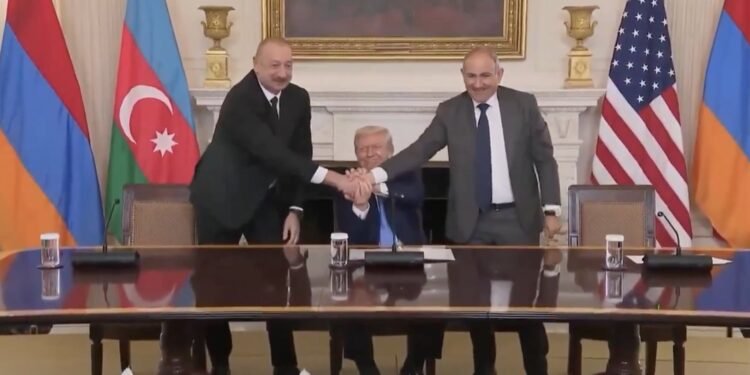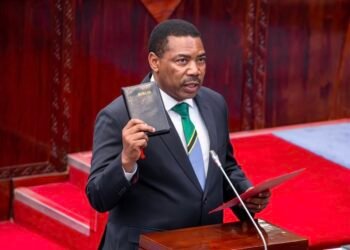WASHINGTON: Armenia and Azerbaijan have signed a landmark U.S.-brokered peace agreement at the White House, ending decades of hostility over Nagorno-Karabakh and paving the way for full normalization of relations.
Flanked by Azerbaijani President Ilham Aliyev and Armenian Prime Minister Nikol Pashinyan, U.S. President Donald Trump hailed the accord as “a long time — 35 years, they fought, and now they’re friends, and they’re going to be friends for a long time.”
The deal commits the South Caucasus rivals to cease hostilities, establish diplomatic relations, and respect each other’s territorial integrity. A centerpiece is the “Trump Route for International Peace and Prosperity” (TRIPP), a strategic transit corridor linking Azerbaijan to its Nakhchivan exclave through southern Armenia. Armenia will grant the United States exclusive development rights over the corridor, which the White House says will boost regional trade and energy exports. Nine companies, including three American firms, have already expressed interest.
The U.S. has also signed separate agreements with both nations to expand cooperation in energy, trade, technology, and artificial intelligence. Washington lifted restrictions on defense cooperation with Azerbaijan, a move likely to unsettle Moscow, which considers the region within its sphere of influence.
Aliyev praised the corridor’s economic potential, saying it would “create connectivity opportunities for so many countries.” Pashinyan called the deal “a significant milestone” and vowed to build a future of cooperation over conflict. Both leaders said they would nominate Trump for the Nobel Peace Prize.
Geopolitical Shift in the Caucasus
The agreement effectively ends the OSCE Minsk Group’s long mediation role and strengthens Western influence in a region neighboring Russia, Turkey, Iran, and Europe. Analysts say the deal sidelines Moscow and could reshape the balance of power by creating a major trade and energy route bypassing both Russia and Iran.
Iran welcomed the accord as “an important step toward lasting regional peace” but warned against foreign military presence near its borders.
Brett Erickson, a sanctions policy adviser at Loyola University Chicago, said the deal gives the West a rare chance to “shut down the evasion pipelines” that have allowed Russia to circumvent sanctions.
Tina Dolbaia of the Center for Strategic and International Studies called the signing “a big symbolic move” but questioned which U.S. companies would control the corridor and how Russia might respond. Olesya Vartanyan, an independent expert, warned that without continued U.S. engagement, the deal risks stalling, given Armenia and Azerbaijan’s long history of failed talks and violent flare-ups.
Part of a Larger Trump Peace Push
The Trump administration has presented the deal as part of a broader foreign policy record in Trump’s second term, crediting him with brokering ceasefires between Cambodia and Thailand, Rwanda and the Democratic Republic of the Congo, and Pakistan and India.
However, Trump has yet to secure an end to Russia’s war in Ukraine or Israel’s conflict with Hamas in Gaza. He announced plans to meet Russian President Vladimir Putin in Alaska on August 15 to work toward resolving the Ukraine war.
Senior U.S. officials say the Armenia–Azerbaijan peace accord marks the end of the first “frozen conflict” on Russia’s periphery since the Cold War, signaling that Washington is now the primary diplomatic force in the Caucasus.
Human rights group Freedom Now urged Trump to press Aliyev to release an estimated 375 political prisoners. Azerbaijan, an oil-rich state that hosted last November’s UN climate summit, has rejected Western criticism of its human rights record as interference.
If sustained, the agreement could permanently transform the South Caucasus, a region long defined by closed borders, ethnic strife, and great power rivalry with Washington, not Moscow, at the helm.
-EMMY SMITH





















